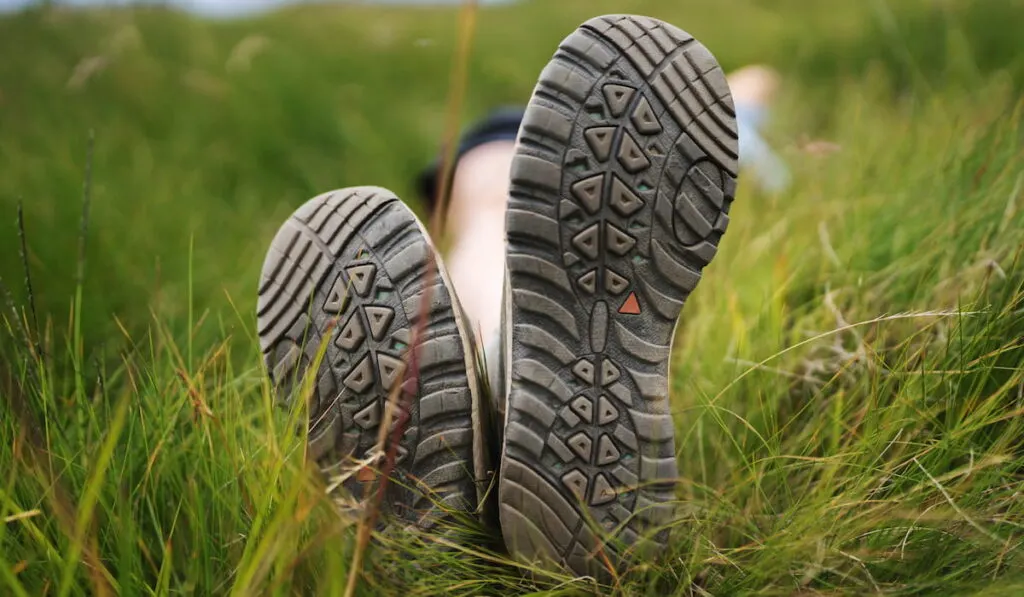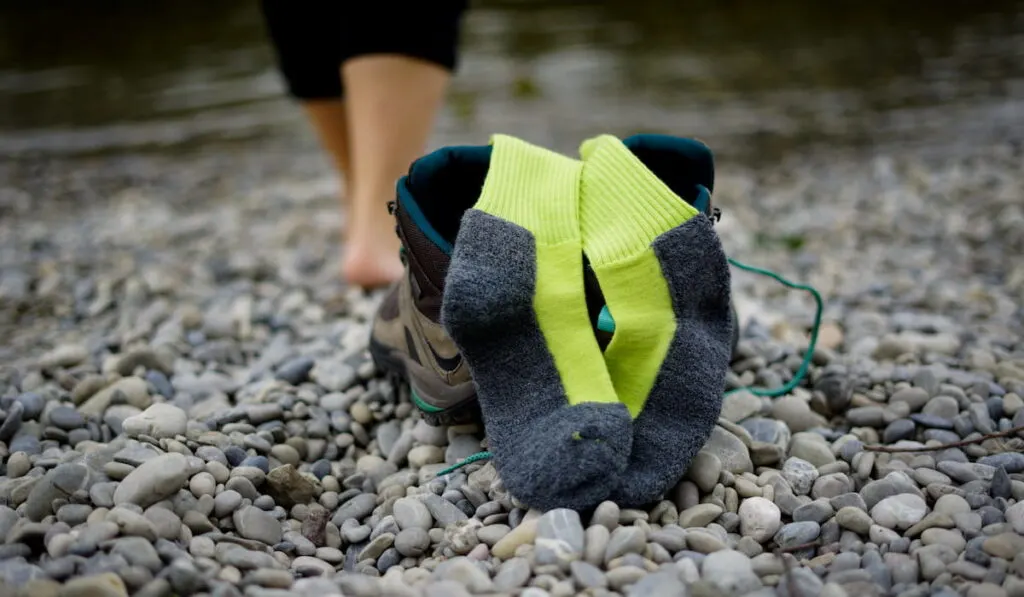Most hikers want as much toe room as possible in their hiking boots to keep their toes comfortable and avoid blisters from their toes rubbing against each other or the boot.
How much toe room should there be in hiking boots?
While there’s no universal measurement on how much toe room you should have, a basic guideline to follow is that you should buy hiking boots that give your toes plenty of room to breathe. A good hiking boot will feel snug around your ankle and heel, with some space around the toes.
Hiking boots must strike a balance between providing protection, stability, and comfort.
You need good boots to keep your ankles from bending too much as you climb up rocks and over roots. Your boots must be solid enough to protect your feet when stepping on sharp rocks and sticks and soft enough to give you a cushion.

Hikers want shoes they feel comfortable in but that offer high-level performance for as long as the hike goes.
Nothing beats trying on several different hiking boots to find what feels best. When it comes to toe room, some people will like a tighter feel that gives them more control, while others will want more room in the toe.
If you’re looking for the perfect hiking boot with the ideal amount of toe room, here are the main features you should pay attention to.
Table of Contents
Focus on Fit First
Have you ever bought a pair of shoes that looked awesome but, at the end of the day, simply didn’t feel right on your feet? If you spent a good amount of money on them, you probably kept wearing them, rueing the fact that you ever bought them.
Anytime you wear them, you come home with sore feet or a blister or two. So it’s not worth it, but we do it again and again in the name of fashion.
While this is a mistake you can get away with for dress shoes or your favorite pair of sneakers, you’ll end up regretting the decision if you buy hiking boots that don’t fit well.
With hiking boots, the fit is the most important thing.

When you buy hiking boots, you should focus on three things:
Toe Room
Your toes shouldn’t touch the front of your boot when you try them on.
Your boots shouldn’t be big enough that your toes slide to the front when you step. A good hiking boot will feel snug around your ankle and heel, with a bit of room around the toes.
Ideally, you’ll be able to wiggle your toes a bit and even curl them if you have to.
Ankle Support
Depending on your hiking experience and skill level, you should find a hiking boot with appropriate ankle support.
New hikers should buy high-top boots because they protect you most from ankle sprains and sore muscles. When you start hiking, you’re exercising tiny muscles and tendons that you likely never have before.
Strong ankle support keeps your steps in sync.
As you gain experience, you can move into mid boots or even trail running shoes. For that to happen, you need to condition your feet, ankles, and knees first.
Heel Cushion
You need a good amount of heel cushion in a good hiking boot to prevent stress fractures. This is especially important for people who go on longer treks.

Why Do You Need More Toe Room in Hiking Boots?
So, what’s the deal with needing toe room in a hiking boot? We’ve already mentioned blisters, but there are other reasons why more room is better for hikers.
First, increased toe room gives your feet room to grow!
Yes, you read that correctly. When you go on a long hike, your feet swell and become bigger. If you buy shoes that fit too tightly, you’re going to feel it when you cross mile ten on a multi-day trek.
Your feet and toes will swell much larger than you likely think possible, so having the extra room up front is a must. You can always loosen your laces but can’t extend the front of your boot after you buy it.
Second, when your toes are cramped and wet from sweat or water you encounter on your hike, it’s much easier for fungal infections to grow. No hiker wants to deal with that because it can become very itchy and painful.
Staying dry is something you should look for in a hiking boot, but giving your toes room to breathe will also help keep them safe from infection.
Third, hiking boots with room in the toes also give you options when it comes to the socks you wear.
For example, if you’re hiking in colder weather or at altitude, you’ll want heavier, thicker socks to keep your feet warm. Also, you can wear multiple layers of socks if necessary and can always shed them once you warm up.
Avoiding Too Much Toe Room
There are limits, of course, to how much toe room you want in a good hiking boot.
If you have too much room in the toes, you’re going to hurt yourself going downhill. With every step, your toes and toenails will slam into the hard front of your boot. You’ll end up with bruised nails and painful feet.
The rule of thumb here is to have enough room for your toes to wiggle without sliding back and forth in the boot.
Too much room will also make it harder to grip when you’re going uphill. You’ll have less control over the front of your boots, making it more difficult to gain sure footing on uneven terrains like gravel or rocks.
How to Try on Hiking Boots
Your hiking boots are arguably your most important piece of gear when you’re walking around in nature.
It doesn’t matter what kind of jackets, pants, poles, or anything else you have—without the proper footwear, foot pain can quickly become unbearable.
Set yourself up the right way for any type of hiking condition by buying a high-quality pair of versatile hiking boots that fit correctly!
Go to a Specialty Hiking Store
Going to a hiking equipment store will likely offer you more choices and customer service associates who know what they are doing.
Most of the time, these stores like to hire people who enjoy hobbies related to the equipment they are selling. So, you’ll probably run into a sales associate in the store who loves to hike and can help you find the perfect hiking boot for your feet.
Measure Your Feet

Measure the length and width of your feet to find the right boot. Then, when you try on shoes, you should be able to fit a finger between your heel and the back of the boot when your toes are pushed all the way forward.
This single-finger rule will give your toes enough room to breathe and flexibility for the type of socks you wear. It will also offer enough space when your feet swell up on long hikes.
Try to buy your boots later in the day or after you’ve gone on a run. Your feet will already be larger than when you first wake up in the morning.
If you try them on when your feet are the smallest, you may be uncomfortable when hiking and after your feet swell later in the day.
Mimic Downhill Hiking
Find a way to mimic how your boots will feel going down steeper hills. ITrywalking down a steep sidewalk or landscaping outside the store. if possible
If that’s a stretch, you can stand up on your toes, bend the material, and walk around like you would if you wore high heels.
Mimicking high heels will indicate whether your toes will smash into the front of your boot. If they do, then you probably have too much room up front.

What Goes into Your Hiking Boots?
An important thing to remember is that your hiking boots won’t only have your feet in them.
You’ll have hiking socks, certainly, but you may also pack a pair of thick thermal socks for when things get cold.
Plenty of hikers find interesting ways to keep their feet comfy on long hikes. Some hikers hike with heel inserts to add a cushion that lowers the impact on heels with every step.
If you can, bring whatever you typically use along when you go to try on a pair of new boots. It will paint a realistic picture of how they’ll fit when you’re out on the trail.
Final Thoughts
Finding the perfect hiking boot can be tough. Most hikers go through several pairs until they find something that fits great and keeps their feet nice and comfortable. Knowing what to look for and how much toe room you’ll need can help you get there faster.
The right hiking boot will keep your feet at the right temperature and help you avoid injuries that could sideline you while your friends are still out hiking. So take the time to find a good boot with just the right amount of toe room to make hiking even more fun!

